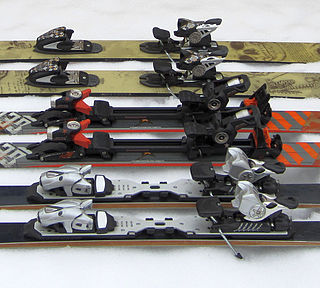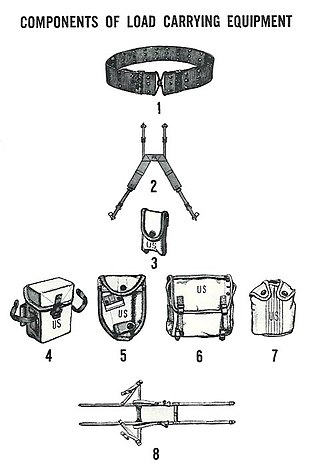Tack is equipment or accessories equipped on horses and other equines in the course of their use as domesticated animals. This equipment includes such items as saddles, stirrups, bridles, halters, reins, bits, and harnesses. Equipping a horse is often referred to as tacking up, and involves putting the tack equipment on the horse. A room to store such equipment, usually near or in a stable, is a tack room.

A shoe is an item of footwear intended to protect and comfort the human foot. Though the human foot can adapt to varied terrains and climate conditions, it is vulnerable, and shoes provide protection. Form was originally tied to function but over time shoes also became fashion items. Some shoes are worn as safety equipment, such as steel-toe boots, which are required footwear at industrial worksites.

A ski binding is a device that connects a ski boot to the ski. Before the 1933 invention of ski lifts, skiers went uphill and down and cross-country on the same gear. As ski lifts became more prevalent, skis—and their bindings—became increasingly specialized, differentiated between alpine (downhill) and Nordic styles of skiing. Until the point of divergence in the mid-20th century, bindings held the toe of a flexible, leather boot against the ski and allowed the heel to rise off the ski, typically with a form of strap or cable around the heel.

Bondage cuffs are restraints designed for use in sexual bondage situations. Compared to conventional handcuffs, they are wide wrist and ankle restraints generally made of leather, often padded with soft leather or fake fur. Bondage cuffs may be fastened at the wrists and/or ankles by a locking mechanism, by a buckle or by velcro. They are secured around the wrist or ankle, and the cuffs may then be attached to each other or another object.
Ski boots are footwear used in skiing to provide a way to attach the skier to skis using ski bindings. The ski/boot/binding combination is used to effectively transmit control inputs from the skier's legs to the snow.

A riding boot is a boot made to be used for horse riding. The classic boot comes high enough up the leg to prevent the leathers of the saddle from pinching the leg of the rider, has a sturdy toe to protect the rider's foot when on the ground and has a distinct heel to prevent the foot from sliding through the stirrup. The sole is smooth or lightly textured to avoid being caught on the tread of the stirrup in the event of a fall.

Chaps are sturdy coverings for the legs consisting of leggings and a belt. They are buckled on over trousers with the chaps' integrated belt, but unlike trousers, they have no seat and are not joined at the crotch. They are designed to provide protection for the legs and are usually made of leather or a leather-like material. Their name is a shortened version of the Spanish word chaparajos. Chaparajos were named after the chaparral, from which they were designed to protect the legs while riding on horseback. Like much of western American horse culture, the origin of chaparajos was in the south of Spain, from which it then passed on to the part of New Spain that later became Mexico, and has been assimilated into cowboy culture of the American West. They are a protective garment to be used when riding a horse through brushy terrain. In the modern world, they are worn for both practical work purposes and for exhibition or show use. Chaps have also been adopted for use on motorcycles, particularly by cruiser-style motorcycle riders.

Sandals are an open type of shoe, consisting of a sole held to the wearer's foot by straps going over the instep and around the ankle. Sandals can also have a heel. While the distinction between sandals and other types of footwear can sometimes be blurry, the common understanding is that a sandal leaves all or most of the foot exposed. People may choose to wear sandals for several reasons, among them comfort in warm weather, economy, and as a fashion choice. Usually, people wear sandals in warmer climates or during warmer parts of the year in order to keep their feet cool and dry. The risk of developing athlete's foot is lower than with enclosed shoes, and the wearing of sandals may be part of the treatment regimen for such an infection.

Motorcycle boots are associated with motorcycle riders and range from above ankle to below knee boots. They have an outside of a typical boot but a low heel to control the motorcycle. To improve motorcycle safety, motorcycle boots are generally made from a thick, heavy leather and may include energy absorbing and load spreading padding, metal, plastic and/or composite materials to protect the motorcycle rider's feet, ankles and legs in an accident. For use in wet weather, some boots have a waterproof membrane lining such as Gore-Tex or SympaTex.

Tanker boots are military boots closely associated with soldiers who serve on tanks. The tanker boot was "designed by Dehner's own H. E. Ketzler and General George S. Patton Jr. in 1937" who "wanted something easy and fast to get on." Regular combat boots are laced through metal eyelets in the leather upper, but the tanker boots are fastened with leather straps which wrap around the upper and buckle near the top. This benefits the wearer in several ways:

Knee-high boots are boots that rise to the knee, or slightly thereunder or over. They are generally tighter around the leg shaft and ankle than at the top. Originally made of leather, versions made of a synthetic rubber, they are used by fishermen, dairy workers, stable hands, duck hunters, clammers, etc. to protect the feet from water, mud, manure, etc. and to provide traction on slippery surfaces. Most slip on, but there are varieties with buckles or zippers, and those that lace up. They may, or may not, have high heels or platforms.

Breeches are an article of clothing covering the body from the waist down, with separate coverings for each leg, usually stopping just below the knee, though in some cases reaching to the ankles. Formerly a standard item of Western men's clothing, they had fallen out of use by the mid-19th century in favour of trousers.

A court shoe or pump is a shoe with a low-cut front, or vamp, with either a shoe buckle or a black bow as ostensible fastening. Deriving from the 17th and 18th century dress shoes with shoe buckles, the vamped pump shape emerged in the late 18th century. By the turn of the 19th century, shoe buckles were increasingly replaced by black bows, which has remained the contemporary style for men's formal wear, leather or patent leather evening pumps ever since. This latter style is sometimes also called an opera pump or opera slipper.

Jodhpurs, in their modern form, are tight-fitting trousers to the ankle, where they end in a snug cuff, and are worn primarily for horse riding. The term is also used as slang for a type of short riding boot, also called a paddock boot or a jodhpur boot, because they are worn with jodhpurs. According to Tara Mayer, "Jodhpurs … exemplify the material and cultural exchanges between Britain and its Indian colony in the nineteenth and early twentieth centuries."

Chelsea boots are close-fitting, ankle-high boots with an elastic side panel. They often have a loop or tab of fabric on the back of the boot, enabling the boot to be pulled on. The boot dates back to the Victorian era, when it was worn by both men and women.

Ammunition boots are a form of military footwear. They were the standard combat boot for the British Army and other forces around the British Empire and Commonwealth from at least the mid-1860s until their replacement a century later in the 1960s with the rubber-soled Boots DMS.

The M-1956 Load-Carrying Equipment (LCE), also known as the Individual Load-Carrying Equipment (ILCE), was developed by the U.S. Army and first issued in the early 1960s. The M-1956 LCE was designed to replace the M-1945 Combat Pack, the M-1923 cartridge belt, the M-1936 pistol belt and the M-1937 BAR magazine belt. The M-1956 LCE was designed to be quickly configured, using no tools, to accommodate various mission and ammunition loads. The M-1956 LCE remained in service through the 1980s and set the standard for future United States military load-carrying equipment.
Jodhpur is the second largest city in the Indian state of Rajasthan.

Brushing boots or splint boots are used to protect a horse's legs during exercise, protecting the lower leg from injury that may occur if one leg or hoof strikes the opposite leg. They are commonly seen on horses in fast work, such as jumping, when in training, such as when longeing, or in competitions such as reining or eventing. Brushing injuries are more common on the forelegs, when one hoof catches the other leg, or when the fetlock or cannon bones hit each other. This can cause a serious injury on a horse's legs, especially if the horse is wearing shoes. Poor equine conformation can often lead to brushing, although even properly-conformed horses can also accidentally injure themselves. Brushing boots may also be placed on horses in the field to protect them if they get overly excited. Other reasons for use may include placement on a young or unfit horse which may be excitable and step on itself, or on horses subject to intense work that may stumble more if they are tired.
The Medieval period in England is usually classified as the time between the fall of the Roman Empire to the beginning of the Renaissance, roughly the years AD 410–1485. For various peoples living in England, the Anglo-Saxons, Anglo-Danes, Normans and Britons, clothing in the medieval era differed widely for men and women as well as for different classes in the social hierarchy. The general styles of Early medieval European dress were shared in England. In the later part of the period, men's clothing changed much more rapidly than women's styles. Clothes were very expensive and both the men and women of lower social classes continued also divided social classes by regulating the colors and styles these various ranks were permitted to wear. In the early Middle Ages, clothing was typically simple and, particularly in the case of lower-class peoples, served only basic utilitarian functions such as modesty and protection from the elements. As time went on the advent of more advanced textile techniques and increased international relations, clothing gradually got more and more intricate and elegant, even with those under the wealthy classes, up into the renaissance.


















